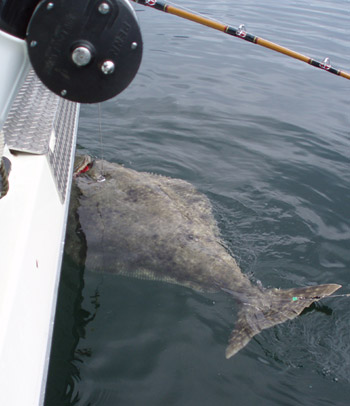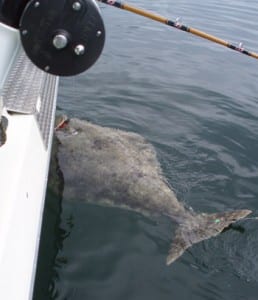A 45-day public comment period opens today for a catch sharing plan allocating halibut between the commercial and charter fishing fleets in Southeast and the Central Gulf of Alaska.
For iFriendly audio, click here:
The plan was recommended by the North Pacific Fishery Management Council last fall and the public comment period is part of the process for implementing new federal regulations.
“It will change the annual process of allocating halibut between the charter and commercial fisheries in Southeast and Southcentral Alaska,” said Rachel Baker, a fishery management specialist with NOAA Fisheries in Alaska. “It will establish allocations for each sector and then specify methods for setting harvest restrictions for charter anglers.”
The proposed system would allocate a percentage of the combined charter and commercial catch to the charter fleet. That percentage changes depending on the overall amount set each year by the International Pacific Halibut Commission. And it’s expected the North Pacific council will make annual recommendations for charter fleet management measures, bag limits and size limits for instance, to keep the charter catch at the allocation levels. The plan would replace a guideline harvest level system, or a desired target of halibut, currently in place for the charter fleet.
Baker said the catch share plan also creates a system for the commercial halibut fleet to transfer individual fishing quota or IFQs to the charter fleet, under what’s called the Guided Angler Fish program. “It’s a voluntary program. No one is required to use the guided angler fish program. It’s just intended to give IFQ permit holders and charter permit holders some flexibility when charter harvest limits are something less than what’s in place for unguided anglers.”
Southeast’s charter fleet has seen restrictions on the size of fish clients can keep over the past few years as federal fishery managers tried to keep the overall catch within a guideline harvest level. In 2011, the charter fleet had a 37-inch maximum. Last year and this year guided anglers have been fishing under a reverse slot limit, allowing clients to keep fish up to 45 inches, and larger than 68 inches. Those limits have also included a one-fish bag limit.
Heath Hilyard is executive director of the Southeast Alaska Guides Organization. He said the biggest concern with the plan is the allocation level set for the charter fleet. “You know the last several years we’ve done very well and there’s been a modicum of recovery from the 37-inch rule in 2011 with the reverse slot limit we’ve been fishing under. It’s not ideal but its certainly something that operators and clients seem to be more attune to. This catch sharing plan we’re suspicioning that we’re gonna be looking at something like maybe a 40-inch maximum to live within what the allocation looks like it would be.”
Hilyard says SEAGO is hoping for changes in the final catch share plan that’s implemented. “I think that we’re at a point where, it’s not a matter of if the CSP goes into effect, it’s a matter of when. So I guess, where we’re at right now is we’re going to do our very best to make sure whatever CSP is finally put in place does as little damage as possible. We’re in a place where we understand damage is inevitable and now it’s a matter of managing it to the extent to minimize it as much as possible to the sector.”
The catch share plan has support from the commercial fishing industry. “This allocation sets both sectors on an abundance-based management strategy,” said Linda Behnken, executive director of the Alaska Longline Fisherman’s Association and president of the Halibut Coalition. “It’s a cornerstone of all commercial fisheries management and adds the charter fleet to that fold. So we’re supportive of the catch sharing plan, like to see it move ahead quickly for implementation in 2014.”
Behnken noted years of both the charter and commercial fleets going over catch targets, prior to the IFQ system and under the charter guideline harvest level. “Probably one of the most important aspects of the catch sharing plan is it does minimize the chance of either sector, charter or commercial, exceeding their allocation and that’s important for resource conservation and also clearly an important tenant of management, while at the same time providing stability to both sectors and essential harvesting opportunities.” Behnken said commercial fleet members are making arrangements to take advantage of the provision allowing transfer of quota share to the charter fleet.
Public comment closes August 12. The National Marine Fisheries Service will use the public comments to compile a final rule, and if implemented, the allocation plan could be in place for the 2014 season.











